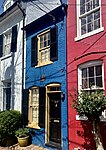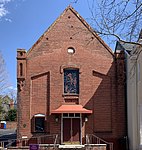Lloyd House (Alexandria, Virginia)
Georgian architecture in VirginiaHistoric American Buildings Survey in VirginiaHouses completed in 1797Houses in Alexandria, VirginiaHouses on the National Register of Historic Places in Virginia ... and 3 more
Libraries in VirginiaNational Register of Historic Places in Alexandria, VirginiaTourist attractions in Alexandria, Virginia

The Lloyd House, also known as the Wise-Hooe-Lloyd House, is a historic house and library located at 220 North Washington Street at the corner of Queen Street in the Old Town area of Alexandria, Virginia. It was built from 1796 to 1797 by John Wise, a prominent entrepreneur, in the late eighteenth-century Georgian architectural style. The house was added to the National Register of Historic Places on July 12, 1976.
Excerpt from the Wikipedia article Lloyd House (Alexandria, Virginia) (License: CC BY-SA 3.0, Authors, Images).Lloyd House (Alexandria, Virginia)
North Washington Street, Alexandria
Geographical coordinates (GPS) Address Nearby Places Show on map
Geographical coordinates (GPS)
| Latitude | Longitude |
|---|---|
| N 38.806944444444 ° | E -77.046944444444 ° |
Address
North Washington Street 217
22314 Alexandria
Virginia, United States
Open on Google Maps








